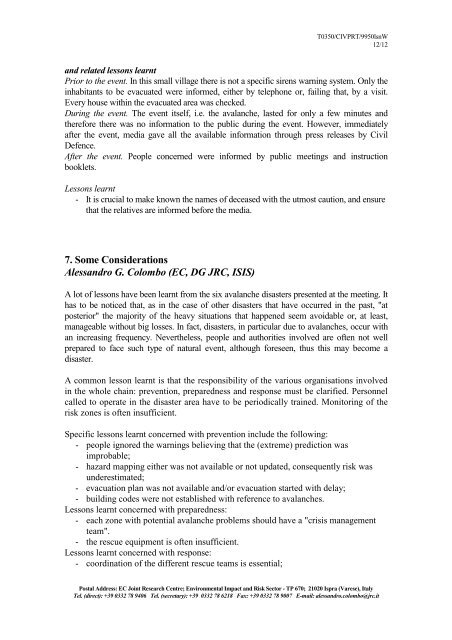lessons learnt from avalanche disasters - PreventionWeb
lessons learnt from avalanche disasters - PreventionWeb
lessons learnt from avalanche disasters - PreventionWeb
You also want an ePaper? Increase the reach of your titles
YUMPU automatically turns print PDFs into web optimized ePapers that Google loves.
T0350/CIVPRT/9950lsnW<br />
12/12<br />
and related <strong>lessons</strong> <strong>learnt</strong><br />
Prior to the event. In this small village there is not a specific sirens warning system. Only the<br />
inhabitants to be evacuated were informed, either by telephone or, failing that, by a visit.<br />
Every house within the evacuated area was checked.<br />
During the event. The event itself, i.e. the <strong>avalanche</strong>, lasted for only a few minutes and<br />
therefore there was no information to the public during the event. However, immediately<br />
after the event, media gave all the available information through press releases by Civil<br />
Defence.<br />
After the event. People concerned were informed by public meetings and instruction<br />
booklets.<br />
Lessons <strong>learnt</strong><br />
- It is crucial to make known the names of deceased with the utmost caution, and ensure<br />
that the relatives are informed before the media.<br />
7. Some Considerations<br />
Alessandro G. Colombo (EC, DG JRC, ISIS)<br />
A lot of <strong>lessons</strong> have been <strong>learnt</strong> <strong>from</strong> the six <strong>avalanche</strong> <strong>disasters</strong> presented at the meeting. It<br />
has to be noticed that, as in the case of other <strong>disasters</strong> that have occurred in the past, "at<br />
posterior" the majority of the heavy situations that happened seem avoidable or, at least,<br />
manageable without big losses. In fact, <strong>disasters</strong>, in particular due to <strong>avalanche</strong>s, occur with<br />
an increasing frequency. Nevertheless, people and authorities involved are often not well<br />
prepared to face such type of natural event, although foreseen, thus this may become a<br />
disaster.<br />
A common lesson <strong>learnt</strong> is that the responsibility of the various organisations involved<br />
in the whole chain: prevention, preparedness and response must be clarified. Personnel<br />
called to operate in the disaster area have to be periodically trained. Monitoring of the<br />
risk zones is often insufficient.<br />
Specific <strong>lessons</strong> <strong>learnt</strong> concerned with prevention include the following:<br />
- people ignored the warnings believing that the (extreme) prediction was<br />
improbable;<br />
- hazard mapping either was not available or not updated, consequently risk was<br />
underestimated;<br />
- evacuation plan was not available and/or evacuation started with delay;<br />
- building codes were not established with reference to <strong>avalanche</strong>s.<br />
Lessons <strong>learnt</strong> concerned with preparedness:<br />
- each zone with potential <strong>avalanche</strong> problems should have a "crisis management<br />
team".<br />
- the rescue equipment is often insufficient.<br />
Lessons <strong>learnt</strong> concerned with response:<br />
- coordination of the different rescue teams is essential;<br />
Postal Address: EC Joint Research Centre; Environmental Impact and Risk Sector - TP 670; 21020 Ispra (Varese), Italy<br />
Tel. (direct): +39 0332 78 9406 Tel. (secretary): +39 0332 78 6218 Fax: +39 0332 78 9007 E-mail: alessandro.colombo@jrc.it












![View full document [PDF 988.55 KB] - PreventionWeb](https://img.yumpu.com/47733942/1/184x260/view-full-document-pdf-98855-kb-preventionweb.jpg?quality=85)
![View full document (in French) [PDF 4.96 MB] - PreventionWeb](https://img.yumpu.com/47223870/1/184x260/view-full-document-in-french-pdf-496-mb-preventionweb.jpg?quality=85)


![View full document [PDF 25.02 MB] - PreventionWeb](https://img.yumpu.com/44204570/1/190x234/view-full-document-pdf-2502-mb-preventionweb.jpg?quality=85)
